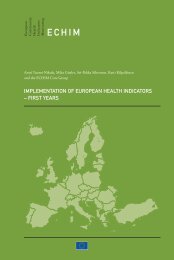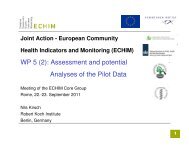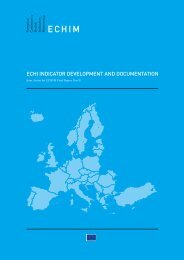INDICATORS
ECHIM Final Report
ECHIM Final Report
Create successful ePaper yourself
Turn your PDF publications into a flip-book with our unique Google optimized e-Paper software.
Table 3. A Documentation Sheet for an indicator that has only one definition and method of<br />
calculation: Total fertility rate (ECHI shortlist indicator #4).<br />
ECHIM<br />
Indicator name<br />
Definition of<br />
indicator<br />
Calculation of<br />
the indicator<br />
(numerator,<br />
denominator)<br />
Additional<br />
underlying<br />
concepts<br />
Relevant<br />
dimensions<br />
(subgroups)<br />
(preferred) data<br />
source(s)<br />
Rationale<br />
Data<br />
availability,<br />
quality,<br />
periodicity<br />
References<br />
Work to do<br />
A) Demographic and socio-economic factors<br />
4. Total fertility rate<br />
Total Fertility Rate is defined as the mean number of children per woman<br />
at the end of childbearing age, based on one calendar year data.<br />
Eurostat, WHO, OECD: The mean number of children that would be<br />
born alive to a woman during her lifetime if she were to pass through her<br />
childbearing years (conventionally 15–44, sometimes 15–49) conforming<br />
to the fertility rates by age of a given year. It is therefore the completed<br />
fertility of a hypothetical generation, computed by adding the fertility<br />
rates by age for women in a given year (the number of women at each age<br />
is assumed to be the same).<br />
Total fertility rate (TFR) calculated as a period indicator (e.g. assuming<br />
that age-specific fertility levels remain constant in the future), not by<br />
birth cohorts. Completed fertility rate by birth cohort (CFR) refers to the<br />
average number of children at the end of reproductive period. TFR and<br />
CFR differ significantly if the timing of childbearing differs by time or by<br />
country.<br />
Country (also region), calendar year<br />
Eurostat, WHO, (OECD: Data from Eurostat); regularly updated based<br />
on national data / vital statistics.<br />
Basic demographic data. Total fertility rate is also used to indicate the<br />
replacement level fertility. In more developed countries, a rate of close to<br />
2.1 can be considered to be replacement level.<br />
Basic demographic data, available for all MSs.<br />
WHO HfA: www.euro.who.int/hfadb<br />
OECD Health Data: www.oecd.org<br />
Eurostat (Methodology for the calculation of Eurostat’s<br />
demographic indicators): epp.eurostat.ec.europa.eu/portal/page?_<br />
pageid=1073,46587259&_dad=portal&_schema=PORTAL&p_product_<br />
code=KS-RA-07-006<br />
44










